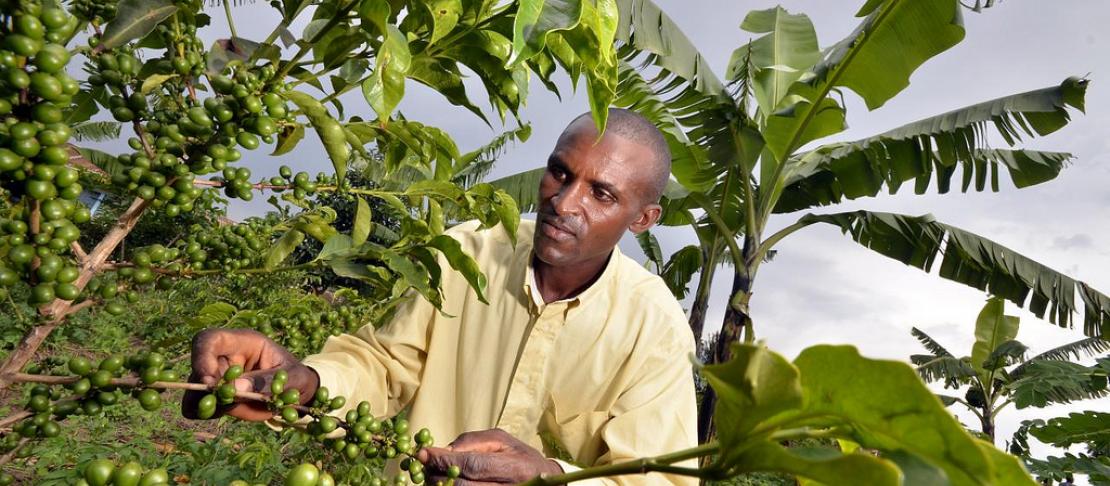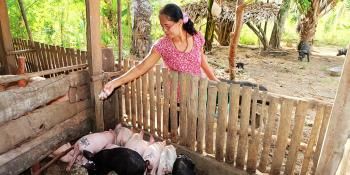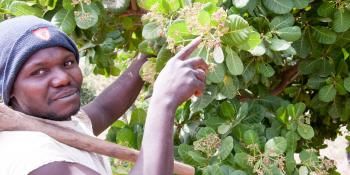Putting banana-coffee intercropping research into action

Summary
Research of the International Institute of Tropical Agriculture (IITA) and its partners shows that growing coffee and banana together is generating >50% more income for smallholder farmers and can help them cope with the effects of climate change. However, turning research into action on the ground requires effective dialogue and communication between researchers and policy makers.
This study looks at how well informed government bodies, private sector and non-profit actors were of IITA’s research and to what extent the practice has been adopted.
Background
Smallholder farmers are disproportionately vulnerable to the impacts of climate change as a result of poverty, marginalization and reliance on natural resources. Climate change will likely negatively affect crop yields and threaten food security in most tropical and sub-tropical regions.
Identifying approaches that strengthen ongoing economic development efforts and enhance the adaptive capacity of farmers, households and communities are therefore vital to counter the effects of climate change (Frank and Buckley 2012).
Scope and methods
The purpose of this study was to validate and enhance the body of outcome evidence at policy level that has led to increased adoption of banana- coffee intercrop systems in a sustainable manner in Uganda and Rwanda; and to gauge in how far IITA/ CCAFS have contributed to this uptake.
In this context, an outcome is broadly defined by CCAFS as ‘the use of the research by non-research partners to change policies and practices’. The study therefore looked not so much as to whether intercropping in accordance with IITA cropping density stipulations had been adopted by farmers but more in how far government bodies, private sector and non-profit actors were aware of the research and were promoting the practice.
After establishing a timeline of the research into the banana-coffee intercropping with IITA staff members and identifying key actors involved in Uganda and Rwanda, face to face interviews were conducted with these actors. This was complemented with a study of relevant scientific literature, media reports and blogs to see if the research results of IITA had achieved wider attention and promotion.
The study also identified actors who had not been initially involved in the research and dissemination of results. Overall, 15 interviews were conducted in Uganda and 11 in Rwanda with government officials, researchers, NGOs and coffee farmer associations. One field visit in Rwanda was undertaken and an interview with a ‘progressive’ farmer conducted.
Outcome evidence from Uganda
Intercropping is not new to Uganda and various organizations have been recommending intercropping of banana and coffee together with other shade trees (Oduol and Alma 1990). A trend analysis of coffee-farming systems in Eastern Uganda suggests that the ratio of intercropping has increased over the past 5 years with currently more than 85% of farmers having at least one plot with coffee and banana intercropped.
Nevertheless about half of the coffee farmers in Central and Western Uganda are reported to still practice monocropping (Bongers et al. 2012). The contribution of IITA has been to scientifically verify the benefits of banana-coffee intercropping and to recommend sustainable ratios of crop density for improved quality and quantities of coffee.
Ootcome evidence from Rwanda
Strict monocropping of coffee has to date been the policy of the government. Coffee farmers, however, are well aware of intercropping practices from neighbouring countries and keen to adopt them to better utilize small plots as well as for the perceived benefits of the practice. High population pressure (Rwanda has the highest population density in Africa) has led many within research and extension communities to recommend intercropping to relieve pressure on land, ensure food security, but also to protect coffee plants from increasing temperatures and erratic weather patterns.
Read the conclusions, recommendations and the full outcome study.


